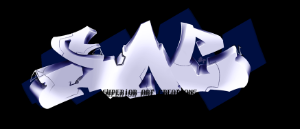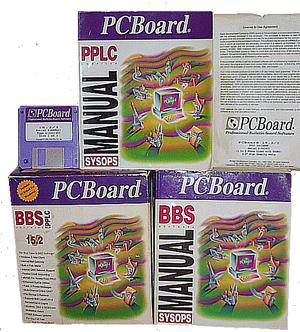
Amiga is a family of personal computers introduced by Commodore in 1985. The original model is one of a number of mid-1980s computers with 16- or 16/32-bit processors, 256 KB or more of RAM, mouse-based GUIs, and significantly improved graphics and audio compared to previous 8-bit systems. These systems include the Atari ST—released earlier the same year—as well as the Macintosh and Acorn Archimedes. Based on the Motorola 68000 microprocessor, the Amiga differs from its contemporaries through the inclusion of custom hardware to accelerate graphics and sound, including sprites and a blitter, and a pre-emptive multitasking operating system called AmigaOS.

A bulletin board system (BBS), also called a computer bulletin board service (CBBS), is a computer server running software that allows users to connect to the system using a terminal program. Once logged in, the user can perform functions such as uploading and downloading software and data, reading news and bulletins, and exchanging messages with other users through public message boards and sometimes via direct chatting. In the early 1980s, message networks such as FidoNet were developed to provide services such as NetMail, which is similar to internet-based email.
MorphOS is an AmigaOS-like computer operating system (OS). It is a mixed proprietary and open source OS produced for the Pegasos PowerPC (PPC) processor based computer, PowerUP accelerator equipped Amiga computers, and a series of Freescale development boards that use the Genesi firmware, including the Efika and mobileGT. Since MorphOS 2.4, Apple's Mac mini G4 is supported as well, and with the release of MorphOS 2.5 and MorphOS 2.6 the eMac and Power Mac G4 models are respectively supported. The release of MorphOS 3.2 added limited support for Power Mac G5. The core, based on the Quark microkernel, is proprietary, although several libraries and other parts are open source, such as the Ambient desktop.
The computer art scene, or simply artscene, is the community interested and active in the creation of computer-based artwork.
FILE_ID.DIZ is a plain-text file containing a brief description of the content of archive to which it belongs. Such files were originally used in archives distributed through bulletin board systems (BBSes) and is still used in the warez scene. FILE_ID stands for "file identification". DIZ stands for "description in zipfile".

Superior Art Creations (SAC) is an underground artscene group which caters primarily to and is well known within the warez scene. SAC members have made, besides ANSI and ASCII art, VGA bitmap graphics, tracker music, and a variety of other works. SAC's character graphics have also been used in bottles and FTP servers.
The Humble Guys (THG) were a cracking group for the IBM PC during the late 1980s founded by two friends known by the pseudonyms Candyman and Fabulous Furlough. The group was also noticed in the demoscene for some of their cracktros.

PCBoard (PCB) was a bulletin board system (BBS) application first introduced for DOS in 1983 by Clark Development Company. Clark Development was founded by Fred Clark. PCBoard was one of the first commercial BBS packages for DOS systems, and was considered one of the "high end" packages during the rapid expansion of BBS systems in the early 1990s. Like many BBS companies, the rise of the Internet starting around 1994 led to serious downturns in fortunes, and Clark Development went bankrupt in 1997. Most PCB sales were of two-line licenses; additional line licenses were also available.

The Major BBS was bulletin board software developed between 1986 and 1999 by Galacticomm. In 1995 it was renamed Worldgroup Server and bundled with a user client interface program named Worldgroup Manager for Microsoft Windows. Originally DOS-based, two of the versions were also available as a Unix-based edition, and the last versions were also available for Windows NT-based servers.
QWK is a file-based offline mail reader format that was popular among bulletin board system (BBS) users, especially users of FidoNet and other networks that generated large volumes of mail. QWK was originally developed by Mark "Sparky" Herring in 1987 for systems running the popular PCBoard bulletin board system, but it was later adapted for other platforms. Herring died of a heart attack in 2020 after being swatted. During the height of bulletin board system popularity, several dozen offline mail readers supported the QWK format.
RelayNet was an e-mail exchange network used by PCBoard bulletin board systems (BBS's). By 1990, RelayNet comprised more than 200 bulletin board systems. BBS's on RelayNet communicated via a communications protocol called RIME.

SPITFIRE is a DOS-based bulletin board system written by Mike Woltz (1945-2022), published by his company Buffalo Creek Software of West Des Moines, Iowa.
Amiga software is computer software engineered to run on the Amiga personal computer. Amiga software covers many applications, including productivity, digital art, games, commercial, freeware and hobbyist products. The market was active in the late 1980s and early 1990s but then dwindled. Most Amiga products were originally created directly for the Amiga computer, and were not ported from other platforms.
AmigaOS is the proprietary native operating system of the Amiga personal computer. Since its introduction with the launch of the Amiga 1000 in 1985, there have been four major versions and several minor revisions of the operating system.
McBBS was a Bulletin Board System developed by Derek E. McDonald and distributed by DMCS Technologies between October 30, 1989 and May 30, 2000 and operated over 18 versions.
Amiga support and maintenance software performs service functions such as formatting media for a specific filesystem, diagnosing failures that occur on formatted media, data recovery after media failure, and installation of new software for the Amiga family of personal computers—as opposed to application software, which performs business, education, and recreation functions.
Warp3D was a project, founded by Haage & Partner in 1998, that aimed to provide a standard API which would enable programmers to access, and therefore use, 3D hardware on the Amiga.






